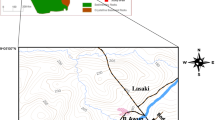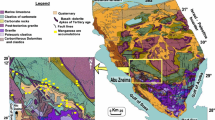Abstract
The aim of this study is to reveal the horizontal and vertical positions of the existing mineralized structures in a small field in Gaziantep province, Şahinbey district, Ortaklar village. After reducing the total magnetic field data of the investigation field to the north pole (RTP), using the data obtained, horizontal gradient magnitude (HGM) and tilt angle map (TAM) techniques were used to investigate the locations of the mineralized structures. The high-amplitude contours of HGM and zero contour of TAM conform to lateral edges of the mineralized structures. Also, the depths of the mineralized structure were determined using the half of the horizontal distance between the ± 45° contours of TAM. Finally, the depth values found with the TAM technique were tested with the 2D inversion technique. For this, the data of the four profiles located at the high-amplitude anomaly locations in the first vertical magnetic gradient anomaly map are used to determine the depth of mineralized structures using the MAG 2D inversion program. The locations of the proposed drillings were determined between 20 and 30 m as a result of both TAM calculations using magnetic data and 2D inversion technique calculations using the first vertical magnetic gradient data.






Similar content being viewed by others
References
Alpaslan N (2011) Magnetic modelling and the interpretation of data process in archeological investigations. Ph. D. Thesis, Kocaeli University, Natural and Applied Sciences, Kocaeli, Turkey)
Arısoy MÖ, Dikmen Ü (2011) Potensoft: MATLAB-based software for potential field data processing, modelling and mapping. Comput Geosci 37:935–942
Blakely RJ, Simpson RW (1986) Approximating edges of source bodies from magnetic and gravity anomalies. Geophysics 51:1494–1498
Cooper GRJ, Cowan DR (2008) Edge enhancement of potential-field data using normalized statistics. Geophysıcs 73:3. https://doi.org/10.1190/1.2837309
Cordell L, Grauch VJS (1985) Mapping basement magnetization zones from aeromagnetic data in the San Juan basin, New Mexico. In: Hinzc WJ (ed) The utility of regional gravity and magnetic anomaly maps. Society Exploration Geophysics, Tulsa, pp 181–197
Elmas A (2018) Kıbrıs Adasındaki Yapısal Süreksizliklerin EGM08 Gravite Verileri Kullanılarak Belirlenmesi. Jeoloji Mühendisliği Dergisi 42:17–32. https://doi.org/10.24232/jmd.434135
Elmas A (2019) Edge position detection and depth estimation from gravity data with application to mineral exploration. Carbonates Evaporites. https://doi.org/10.1007/s13146-018-0480-8
Elmas A, Karslı H, Kadirov FA (2018) Lineaments in the Shamakhy-Gobustan and Absheron hydrocarbon containing areas using gravity data. Acta Geophys. https://doi.org/10.1007/s11600-017-0104-z
Emre Ö, Duman TY, Özalp S, Elmacı H, Olgun Ş, Şaroğlu F (2013) Açıklamalı 1/1.250.000 Ölçekli Türkiye Diri Fay Haritası, Maden Tetkik ve Arama Genel Müdürlüğü, Özel Yayın Serisi-30. Ankara- Türkiye.
Gunn PJ (1975) Linear transformations of gravity and magnetic fields. Geophys Prospect 23:300–312
Güvenç T (1973) Gaziantep-Kilis bölgesi stratigrafisi: MTA Jeoloji Etüd Daire rapor arşivi, Rap. no. 304, 70 s. Ankara
Hansen RO, Pawlowski RS, Wang X (1987) Joint use of analytic signal and amplitude of horizontal gradient maxima for three-dimensional gravity data interpretation, 57th annual international management: Society Exploration Geophysics. Expanded Abstracts, pp 100–102
Last BJ, Kubik K (1983) Compact gravity inversion. Geophysics 48:713–721
Miller HG, Singh V (1994) Potential field tilt-a new concept for location of potential field sources. J Appl Geophys 32:213–217
Nasuti Y, Nasuti A, Moghadas D (2018) STDR: a novel approach for enhancing and edge detection of potential field data. Pure Appl Geophys 176(2):827–841
Oruç B (2010) Edge detection and depth estimation using a tilt angle map from gravity gradient data of the Kozaklı-Central Anatolia Region. Turkey Pure Appl Geophys. https://doi.org/10.1007/s00024-010-0211-0
Oruç B, Keskinsezer A (2008) Structural setting of the northeastern Biga Peninsula (Turkey) from tilt derivatives of gravity gradient tensors and magnitude of horizantal gravity components. Pure Appl Geophys 165:1913–1927
Oruç B, Selim HH (2011) Interpretation of magnetic data in the Sinop area of Mid Black Sea, Turkey, using tilt derivative, Euler deconvolution, and discrete wavelet transform. J Appl Geophys 74:194–204
Pham LT, Oksum E, Do TD, Le-Huy M (2018) New method for edges detection of magnetic sources using logistic function. Geofizicheskiy Zhurnal 40(6):127–135
Pham LT, Vu TV, Thi SL, Trinh PT (2020) Enhancement of potential field source boundaries using an improved logistic filter. Pure Appl Geophys 177:5237–5249
Salem A, Williams S, Fairhead JD, Ravat DJ, Smith R (2007) Tilt-depth method: a simple depth estimation method using first-order magnetic derivatives. Leading Edge, 26 (12), 1489–1624
Stocco S, Godio L, Sambuelli L (2009) Modelling and compact inversion of magnetic data: a matlab code. Comput Geosci 35:2111–2118
Terlemez HÇI, Şentürk K, Ateş Ş, Sümengen M, Oral A (1992) Gaziantep dolayının ve Pazarcık-şakçagöz-Kilis-Elbeyli-Oğuzeli arasının jeolojisi: MTA Rap. no. 9526, Ankara
Ulu Ü, Genç Ş, Giray S, Metin Y, Çörekçloglu E, Örçen S, Ercan T, Yaşar T, Karabıyıkoğlu M (1991) Belveren-Araban-Yavuzeli-Nizip-Birecik dolayının jeolojisi, Senozoyik yaşlı ve volkanik kayaçların petrolojisi ve bölgesel yayılımı: MTA Rap. no. 9226, Ankara
Verduzco B, Fairhead JD, Green CM, Mackenzie C (2004) New insights into magnetic derivatives for structural mapping. Leading Edge 23:116–119
Yoldemir O (1987) Suvarlı-Haydarlı-Narlı Gaziantep arasında kalan alanın jeolojisi, yapısal durumu ve petrol olarakları: TPAO Rap. no. 2257, 60s. Ankara.
Acknowledgements
I would like to thank the precious Rasim Taylan KARA, who contributed to the preparation of this study.
Author information
Authors and Affiliations
Corresponding author
Additional information
Publisher's Note
Springer Nature remains neutral with regard to jurisdictional claims in published maps and institutional affiliations.
Rights and permissions
About this article
Cite this article
Elmas, A. Mineralized structure prospection with depth estimation using magnetic data. Carbonates Evaporites 36, 69 (2021). https://doi.org/10.1007/s13146-021-00740-7
Accepted:
Published:
DOI: https://doi.org/10.1007/s13146-021-00740-7




